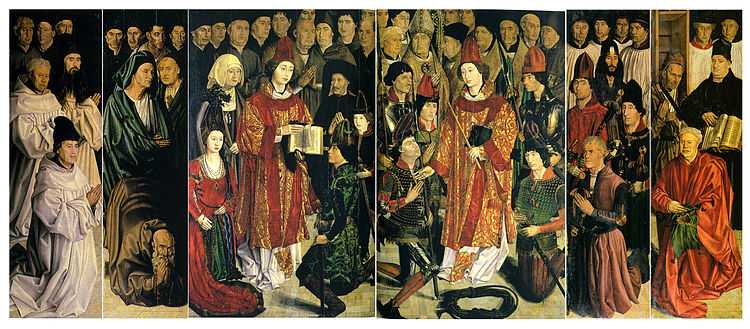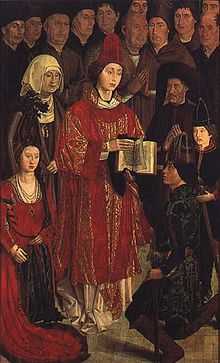Saint Vincent Panels
The Saint Vincent Panels, or the Adoration of Saint Vincent panels, are a polyptych consisting of six panels that were painted in the 1460s. They are attributed to the Portuguese painter Nuno Gonçalves who was active from 1450 to 1471. They are now housed in the Museu Nacional de Arte Antiga (National Museum of Antique Art), in Lisbon, Portugal.
Discovery
Found during the late 1880s in the monastery of Saint Vicente de Fora in Lisbon, they depict Saint Vincent of Saragossa. This polyptych consists of six separate panels of oak, painted with oil or tempera.
The only reference that art historians can use to support the attribution of the painter of the Saint Vincent Panels was written in the 16th century by Francisco de Holanda. The reference mentions a great work of art made by the painter that is inferred to be these panels. It also is speculated that the father of Hugo van der Goes collaborated in the painting of the panels, but no concrete proof exists regarding that supposition.
The skill of the painter of the Saint Vincent Panels is regarded as the highest peak of Portuguese antique art.

Interpretations
Since their discovery in late 19th century there has been a continuing dispute over the identity of the painter and the subjects portrayed on the panels. Some basic questions, still unanswered are,
- what scene, or scenes, are depicted in these panels?
- who are the sixty persons portrayed?
- what is the symbolism of the objects in the panels?
- who ordered these panels painted?
The majority of experts who have studied this polyptych agree that the panels display several social groups of the 15th century. They also agree that the children of King João I are represented on these panels, but they don't agree who is whom.
Panel of the Prince: alternative hypothesis

One of the more controversial issues is the depiction of Prince Henry the Navigator. The man in black in the third panel is immediately consonant with popular conceptions of Prince Henry's likeness - a man with a light moustache and distinctive black round chaperon - which can be found in numerous pictures and statues of Prince Henry today. However, there are strong reasons to doubt that this is him.[1]
.jpg)
First of all, there are no confirmed portraits of Prince Henry. The only other 15th-century image of the man-in-the-chaperon is from the frontispiece of a copy (currently held by the Bibliothèque nationale de France) of Gomes Eanes de Zurara's Crónicas dos Feitos de Guiné, written in 1453.[1] While Zurara's book is an account of the early Portuguese discoveries in Africa, it is also a hagiography of Prince Henry, assigning him singular credit for the discoveries. As a result, it has been assumed that the frontispiece depicts Henry (the motto underneath also seems to have truly been Henry's own.)
On the other hand, a critical part of the discoveries was conducted during the reign of Henry's brother, King Edward of Portugal (r. 1431-38). So one alternative hypothesis that has been forwarded postulates that the man-in-the-chaperon might be King Edward I.[1] It would not be unusual for a portrait of the king to adorn a chronicle of events that happened during his reign.
This alternative hypothesis can be used to help clarify the Panel of the Prince in the St. Vicent polyptych, as being composed of royals only - that is, kings and queens in pairs. Thus, the standing pair would be King Edward (in black chaperon, standing on right) mirroring his wife, Queen Eleanor of Aragon (standing on left). Whereas below them, is their son, King Afonso V of Portugal (kneeling on right) facing his consort, Queen Isabella of Coimbra (kneeling on left). Finally, the boy in the picture is the royal heir, future King John II of Portugal.[1]
This alternative hypothesis seems more intuitive than the original hypothesis that insists on identifying the man-in-chaperon as Prince Henry. That would leave us scrambling to identify the others, e.g. Henry was a bachelor, so who is that woman standing on the left, mirroring him? If that is his mother Philippa, why is her consort, King Joao I, left out? Is it his sister, Isabella, Duchess of Burgundy? Why is she there (and without her husband)? It doesn't seem obvious why a bachelor uncle and an aunt from a distant duchy are hovering over the king and queen, rather than his parents, the former king and queen (and where are they, if not here?). Finally, if one is to insert an uncle in this panel, surely it ought to be Peter of Coimbra, the uncle who was the regent of Afonso V and the father of his bride. Some interpretations try to fix this by asserting Edward is the kneeling king, and Afonso V is the boy. Although Edward was older than Henry, he died young and so maybe there was no later likeness. But all these explanations seem a bit of a stretch simply to accommodate Henry as the man-in-chaperone.
It seems the alternative hypothesis, with King Edward as the man-in-the-black-chaperon, makes more intuitive sense. In that case, we have only royal king and queen pairs in the panel, with no intrusion of other extraneous family members (who are duly confined to their own panel - see below). In this light, the Panel of the Prince perhaps ought to be called the Panel of Kings.
Panel of the Knights: alternative hypothesis

The alternative hypotheses that assert Henry the Navigator is not the man-in-the-round-black-chaperon identify him another panel, the fifth panel known as the 'Panel of the Knights'. The alternative interpretation would indicate that these four knights are the four younger brothers of King Edward of Portugal.[1] Specifically:
- On the right in green is the powerful Peter of Coimbra, who was regent prince during the minority of Afonso V; he is wearing a belt of the Order of the Garter.
- On the left is the constable John of Reguengos, in the red color and blade-holding pose typical of the Order of Santiago, of which he was the master.
- On top, bearded in black with helmet is Ferdinand the Saint, who died after many years in a Moroccan prison. His beard, long hair and emaciated face may reflect his long captivity. The reflection on his helmet seems to form the end of possible a Moorish prison window or (in conjunction with his beard), a Cross fleury, the badge of the Order of Aviz, of which he was master.
- Below, kneeling in purple, is Prince Henry the Navigator, master of the Order of Christ, with what seems like that order's cross pendant on his neck and a loose Order of the Garter belt. The face of this grey-haired Henry is very different from popular portrayals.
There has also been much discussion around the possible political significances of this panel.[1] It seems, in particular, that by the poses, this panel aims to humiliate Henry the Navigator, possibly for having lined up with Afonso of Braganza against his full brother Peter of Coimbra in the Battle of Alfarrobeira in 1449. e.g.
- Henry is on his knees, seemingly begging for forgiveness, while Peter & John seem to "stand guard" over him;
- the pendant Order of Christ cross around Henry's neck is broken,
- Henry's garter belt is untied and disshevelled (Peter's is worn properly),
- the pommel of Henry's sword is twisted, dull and draped in black thread (Peter & John's swords are shiny, laced with gold and silver threads)
- Henry's head penitently uncovered; Peter & John wear their noble caps;
- Peter & John are wearing white gloves (guilt-free 'clean hands'?), Henry is ungloved.
- Henry seems to gaze straight across to another panel (asking forgiveness from the royal dynasty he has 'wronged'?), while Peter & John look at the audience.
It is worth remarking that the colors chosen for the princes seem to match the liturgical colors of the Roman rite - black (Ferdinand) for mourning of the dead, green (Peter) for ordinary, red (John) for passion and sacrifice and purple (Henry) for penance and mortification.[2]
If this is true, then the polyptych of St. Vincent may very well have been conceived by Nuno Gonçalves as a piece of anti-Braganza political propaganda (and one possible reason it might have remained hidden for years).[1]
References
- António Salvador Marques, 1998, Painéis de S. Vicente de Fora (accessed 2010)
- Web Gallery description
- Another Web Gallery link
- New York Times travelogue mention
- Os Painéis em Memória do Infante D. Pedro